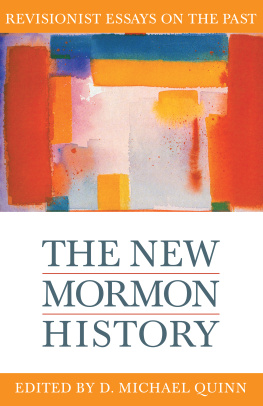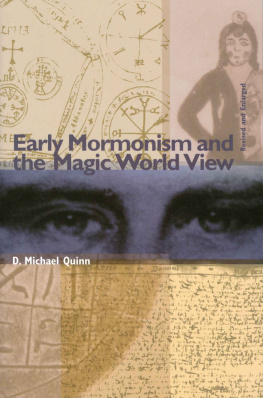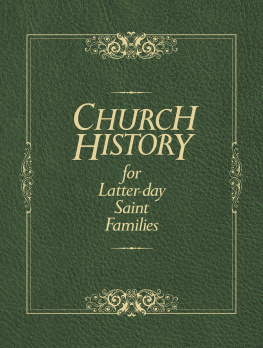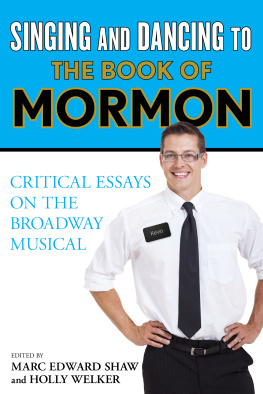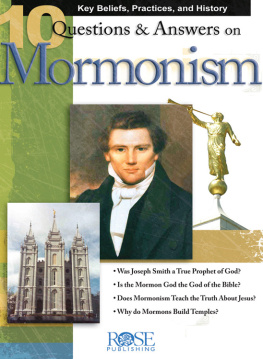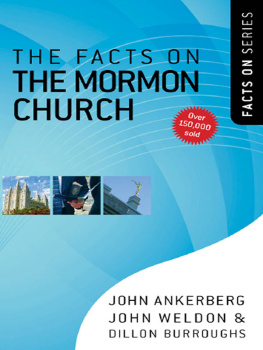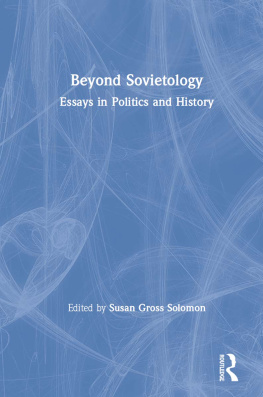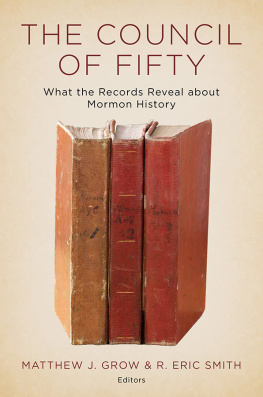THE NEW MORMON HISTORY
Revisionist Essays on the Past
Edited by D. Michael Quinn
Signature Books Salt Lake City 1992
In Memory of Juanita Brooks
Cover illustration: Red Symmetry, by Gary Collins
Cover Design: Julie Easton
Copyright 1992 by Signature Books, Inc.
LIBRARY OF CONGRESS CATALOGING-IN-PUBLICATION DATA
The New Mormon History : revisionist essays on the past / edited by D. Michael Quinn
p. cm.
Included bibliographical references.
ISBN 978-1-56085-011-3 (paperback)
1. Mormon ChurchHistory. 2. Church of Jesus Christ of Latter-day SaintsHistory. 3. Mormon ChurchHistoriography. 4. Church of Jesus Christ of Latter-day SaintsHistoriography. 5. MormonsUnited StatesSocial life and customs. 1. Quinn, D. Michael.
BX8611.N48 1992
289.309dc20
91-21224
CIP
Contents
Editors Introduction
The New Mormon History, for want of a better term, began with the publication of Juanita Brookss The Mountain Meadows Massacre in 1950 by Stanford University Press, but there were certainly antecedents. From the 1900s to the 1930s, assistant church historian Brigham Henry Roberts, despite his shortcomings as a historian, exemplified much of the philosophy later identified with the New Mormon History. The first generation of university-trained Latter-day Saint scholars also made important contributions from the 1930s to the 1950s. Still the flowering of New Mormon History has occurred since the 1950s. In 1961 this outpouring caused Brigham Young University Studies to start publishing an annual Mormon Bibliography.
One aspect of this trend is simply a reflection of a larger process of change in the writing of history generally. Since the 1950s American historians have adopted new techniques and emphases in reexamining familiar topics. This new history examines the experiences of common people and reverses the lack of emphasis on women, children, families, and ethnic minorities. The focus on large populations and common people has stressed the use of statistics and computer analysis. In addition, historians have gained new insights through cross-cultural comparisons and some of the methods and theories of the social sciences. At the same time, sociologists, political scientists, economists, anthropologists, and psychologists have used their skills for historical inquiry.
The New Mormon History includes all of the ingredients of new history in America at large but has one crucial addition: the effort to avoid using history as a religious battering ram. That is why I date the New Mormon History from the publication of Brookss Mountain Meadows Massacre. No topic was more traditionally inviting for sensational exploitation, secular condescension, or smug defensiveness. Yet this devoted Mormon writer did the best a human being can do to be dispassionate in helping readers better understand the context and details of a horrifying act committed by her equally devoted co-religionists of an earlier era.
In her landmark study Brooks avoided seven deadly sins of traditional Mormon history. She did not shrink from analyzing a controversial topic. She did not conceal sensitive or contradictory evidence.
By contrast ultimate historical objectivity is an impossible ideal because the observer historian brings his or her own limitations to the study of the past. Only a person of infinite capacity can understand the past with ultimate objectivity. This is why impassioned arguments against historical objectivity sound strange compared to the imprecise aspiration of writers to be fair and objective.
Any historynew or old, devotional or secularhas fundamental limitations. No historical work is the last word in understanding the seamless past. History is the imprecise effort to give finite understanding to an infinity of separate events and pieces of evidence. No human can completely understand the past as it was or the present as it is. The historian cannot discover all the circumstances surrounding even the simplest event. Therefore history is not the past. History is a quest to understand the past. The New Mormon History is part of that quest.
The changing emphasis in Mormon history has influenced the work of traditional Mormon historians, even as traditional approaches continue.
Not everyone has applauded the functional objectivity toward which the New Mormon Historians strive.
Readers of this volume must judge for themselves whether the above criticisms accurately describe the revisionist articles in this collection. Narrow definitions certainly ignore the diversity of publications the New Mormon History has producedon demography, frontier teenagers, female auxiliary leaders, Mormon relations with native Americans, social origins of British converts, textual reconstruction of the King Follet sermon, and the biography of church president Spencer W. Kimball, for example. Instead critics use New Mormon History as a polemical term within narrow definitions rather than as a descriptive term for this massive and diverse new literature.
In preparing this collection my first list included more than two hundred selections. This, of course, excluded an even larger body of unpublished papers, theses, and dissertations. Even so my list was conservative, since one historian found a thousand significant works since 1950. Next I narrowed that list to seventy-seven articles or excerpts from books. That reduced list seemed so essential that I suggested this collection of essays be multi-volumed. Practical considerations dictated a far smaller compilation.
Surveying the authors of selections on my initial list confirmed that something new has indeed occurred in the writing of Mormon history in recent decades. They were women and men; Mormon, RLDS, Catholic, Protestant, Jewish, Muslim, and Hindu; American, Belgian, British, Canadian, French, German, Indian, Israeli, Italian, New Zealander, and Palestinian; anthropologists, architects, archivists, artists, biblical scholars, biologists, business administrators, classicists, computer programmers, demographers, ecologists, economists, engineers, English teachers, film critics, folklorists, genealogists, geographers, healthcare specialists, historians, housewives, institute teachers, journalists, lawyers, librarians, linguists, mathematicians, museum curators, philosophers, physicians, physicists, political scientists, psychiatrists, psychologists, sociologists, statisticians, university administrators, as well as leaders of both the Church of Jesus Christ of Latter-day Saints and the Reorganized Church of Jesus Christ of Latter Day Saints. Such diversity is evidence of the interdisciplinary and cross-cultural character of the new history.
This collection features fifteen representative essays to demon-strate the impact of New Mormon History in recent decades. In some cases the selections here were the first major reassessments of particular topics and have since been revised by new revisionists. The very richness of the New Mormon History guarantees that any selective publication of important or representative works will be incomplete. Due to practical limits of size, scores of authors and crucial examples are absent. Therefore I can only apologize in advance for the omissions and acknowledge that others might choose differently. It is an imperfect world, but I hope that these essays will provide a useful introduction to the New Mormon History.
Appreciation is extended to the following authors and publications for permission to reproduce, sometimes in a different format, the essays appearing here: to Dialogue: A Journal of Mormon Thought for essays by Thomas G. Alexander, James B. Allen, Leonard J. Arrington, Maurine Ursenbach Beecher, Mario S. De Pillis, and Klaus J. Hansen; to Sunstone magazine for essays by Kenneth L. Cannon II, Linda King Newell, and Ronald W. Walker; to the Utah Historical Quarterly for essays by Eugene E. Campbell and Bruce L. Campbell, and William G. Hartley; to the Journal of Mormon History for the essay by Jan Shipps; to the Western Humanities Review for the essay by Stanley S. Ivins; to the Charles Redd Center for Western Studies for the essay by Dean L. May; and to Coronado Press for the essay by Robert B. Flanders.

